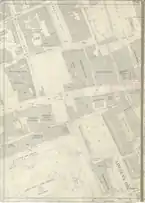Kingsway telephone exchange
Kingsway telephone exchange was a Cold War-era hardened telephone exchange underneath High Holborn in London. Initially built as a deep-level air-raid shelter in the early 1940s, it was instead used as a government communications centre. In 1949 the General Post Office (GPO) took over the building, and in 1956 it became the UK termination point for TAT-1, the first transatlantic telephone cable. Closure of the facility began in the 1980s.
.jpg.webp)
History
The Kingsway telephone exchange was built as a deep-level shelter underneath Chancery Lane tube station in the early 1940s, compromising two east-west aligned tunnels, one each side of the Central Line.[1] Although intended for use as an air raid shelter, like many of the deep level shelters it was not used for its intended purpose and was instead used as a government communications centre. Material from the Public Records Office was stored there from 1945 to 1949.[1]
The site was given to the General Post Office (GPO) in 1949. At the time, the Post Office was also responsible for telephones as well as postal system. The two-tunnel shelter was extended by the addition of four shorter tunnels, at right-angles to the original pair. This extension was completed by 1954, and in 1956 it became the UK termination point for TAT-1, the first transatlantic telephone cable.
Throughout the 1960s, 1970s and early 1980s, Kingsway Trunk Switching Centre (as it became known) was a trunk switching centre and repeater station with Post Office engineering staff totalling over 200 at its peak. Also located on site was the Radio Interference Investigation Group, whose function was to prevent television viewers and radio listeners in north and central London from suffering interference to their service from external sources such as thermostats, fluorescent tubes and injection moulding equipment. The country's first Radiopaging terminal was also installed on this site in the 1970s.
The site had a staff restaurant,[1] tea bar, games room and licensed bar. Its bar claimed to be the deepest in the United Kingdom, located at approximately 200 feet below street level. The site contained an artesian well and rations to maintain several hundred people for many months, ensuring a safe environment in case of nuclear attack.
By the early 1980s the site was subject to a phased closure after large quantities of blue asbestos were found on the site. By 1995 only the main distribution frame was still in service. This reportedly has been removed.
In October 2008, British Telecom announced that the tunnels were for sale.[2][3]
Entrances
Kingsway Telephone Exchange has two entrances. One is next to a shopfront at 32 High Holborn, the other is a goods lift on Furnival Street. A third access point, a combination of ventilation towers and a passenger lift at Tooks Court was demolished in 2001.
Fiction
The Exchange features in the third of James Herbert's Rats trilogy 'Domain', as a place where survivors of a nuclear attack on London take shelter.
References
- Mir, Aly (19 March 2018). "Discovering Holborn's underground lairs". The Telegraph.
- "London tunnel network put on sale". BBC News. 15 October 2008.
- Werdigier, Julia (27 November 2008). "Mile of London Tunnels for Sale, History Included". New York Times.



